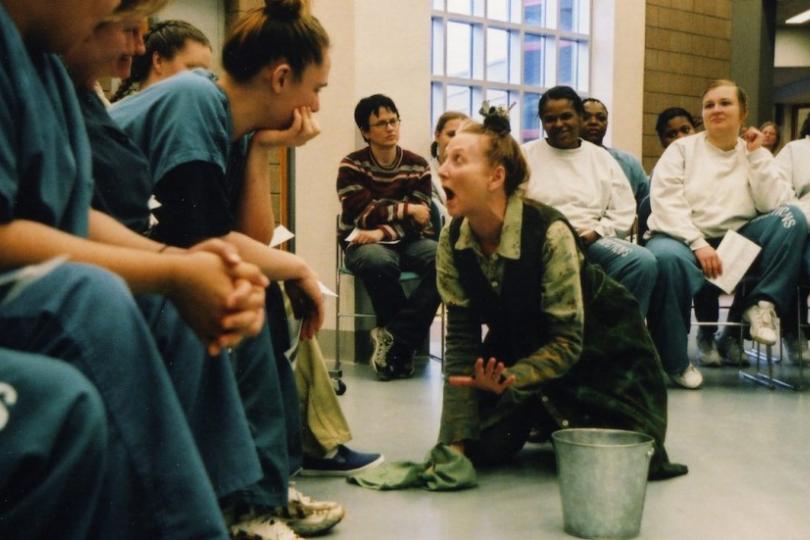Perhaps the most daunting of the many recurring obstacles faced by Ten Thousand Things theater company in founder Michelle Hensley’s new book All the Lights On is the audience’s preconceived notion of what theater is. As a company largely focused on producing high-quality performances for audiences who don’t usually see theater - people in correctional facilities, homeless shelters, housing projects and other underserved communities - Ten Thousand Things frequently comes up against crowds who assume their plays will be preachy, pretentious, boring or some combination thereof.
Not coincidentally, those are exactly the same reactions many unfamiliar observers will have when presented with the prospect of a book about the creative processes and day-to-day operations of what looks at first glance like a low-budget, do-gooder theater troupe in flyover country. But much like Ten Thousand Things has consistently won over dubious crowds with challenging-yet-accessible productions that treat their audiences with respect, All the Lights On proves to be an eminently readable account of a unique accomplishment with universal appeal and applications.
There’s a common conception that books about the artistic process are of interest only to artists within that discipline. As an admitted philistine who writes about theater but has no designs on making it myself, I can attest that this is not the case with All the Lights On. Right from the prologue, in which Hensley recounts her fledgling company’s first attempt to mount Bertolt Brecht’s The Good Person of Szechwan in a Los Angeles homeless shelter, this is a story packed with tension and sharp attention to detail. There’s plenty of appeal here for anyone who likes learning about the way a complex project comes together.
A guide to problem-solving
And it is indeed a complex project. Hensley breaks the Ten Thousand Things story into eleven chapters, each one focused on a specific facet of the company’s philosophy and approach to theater. Those elements range from abstracts like “radiance” and “unexpected connections” to specifics like choosing a script and how to situate actors in relation to the audience (the book’s title comes from Hensely’s belief that putting the performers up on a well-lit stage while the audience sits at a distance in the dark can create an insurmountable gulf). It’s a tremendously effective way to structure this story, as it allows Hensley room to explore each aspect thoroughly and advance the loose narrative arc at the same time.
Hensley writes with a straightforward, precise voice that doesn’t bother with frills or flourishes. That’s also in keeping with the Ten Thousand Things philosophy. Hensley makes no apologies about the company’s tendency to alter or delete portions of established plays that are unlikely to connect with their audiences. Shakespeare gets retooled to turn misogyny into possibility. Nearly every play is cast with a malleable approach to racial and gender roles. Little Shop of Horrors trades in its signature giant man-eating plant for a much simpler hand puppet.
In one of the book’s most striking passages, Hensley and music director Peter Vitale face the dilemma of presenting “I Made a Fist” - a song boisterously celebrating an act of violence - in a prison production of The Most Happy Fella starring former Viking Esera Tuaolo. “Once again, our necessarily spare approach to the material came to the rescue,” Hensley writes. After Vitale jettisons the original brass band arrangement, they’re left with a sparse piano melody that highlights Tuaolo’s vulnerability rather than his intimidating physique. “The song became not a celebration but a sad realization of his discovery of his ability to hurt people.” The anecdote ends, as do many of the stories in All the Lights On, with tears welling in the eyes of an audience that’s seldom allowed the freedom to cry.
Should this be a manifesto?
That’s the bottom line on this book. All of the unorthodox theater practices under the sun wouldn’t count for much if Ten Thousand Things wasn’t consistently connecting with the audience they set out to serve. By Hensley’s account they’ve accomplished that mission many times over, and the company’s continued growth and ever-expanding reach seem to bear that out.
I should note again that I’m not a theater maker. It’s possible or probable that a theater vet would have questions or concerns about this book that would never occur to me. As a layperson, though, it’s a far more identifiable narrative than I would have expected. Hensley’s adherence to the Ten Thousand Things mission and her frequent repetition of the company’s guiding themes do sometimes edge the writing toward manifesto territory, but that’s not necessarily a bad thing either.
In the book’s epilogue, Hensley expresses her worry that inexperienced theater companies will use her book as a “how-to” guide for bringing theater to underserved audiences. Her concern is legitimate - few things can confirm a dubious audience’s anti-theater bias quite as quickly as being subjected to bad theater. For artists who can handle their theatrical liquor, though, this could easily become a bible for bringing great work to nontraditional audiences. I suspect Hensely’s book will make its way onto a number of collegiate required reading lists in the next few years, and deservedly so.
All the Lights On is a fine work of art about the creation of multiple works of art that will be invaluable in fomenting future works of art. You can’t ask for a much better trajectory than that.
Ira Brooker
Ira Brooker is a writer and editor residing in Saint Paul's scenic Midway neighborhood. He holds down a corporate job by day and does freelance and creative work at night. He is a former editor of
Minnesota Playlist and has been published in a number of venues both local and national, several of which you may have even heard of. He occasionally prattles on about pop culture at
A Talent For Idleness and maintains an archive at
irabrooker.com.





